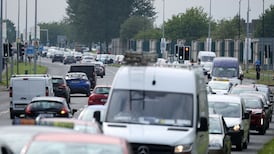When it comes to speed limits, we should be taking cues from the tourists. German visitors, used to long stretches of unrestricted autobahn, baulk at what’s permitted on our back roads.
Some of our local and rural roads, barely wide enough for two cars and regularly populated with pedestrians, cyclists and slow-moving tractors, are designated as 80km/h. That’s the same as many two- or three-lane carriageways on the outskirts of our larger towns and cities.
Many of these rural roads are boreens, twisty, narrow and with big hedges that reduce any opportunity to use the verge.
One problem on these roads is that regular users become complacent. They know every pothole, bump and tight bend. They have driven through that particular blind corner at 75km/h for decades in all weather and nothing has happened. Until something does.
READ MORE
Complacency is a common flaw of all road users, but on these roads it can be deadly. Drivers have few if any options for avoidance.
The worrying rise in road deaths has understandably led authorities to seek out causal links. As part of what the Minister of State for road safety, Jack Chambers, bills as a suite of measures to improve road safety, speed limits are now under review.
Under the proposals, the new default speed limit on national secondary roads would drop from 100km/h to 80km/h. The default speed limit for the network of local and rural roads throughout the country would be reduced from 80km/h to 60km/h.
Urban roads, which include built-up areas such as housing estates and town centres, would reduce to 30km/h. Arterial roads and radial routes around urban settings would be set at 50km/h. There are no proposed changes to the speed limits on motorways and national primary roads contained in the review.
It all chimes with the current road safety concerns. However, a major issue with such measures is credibility.
This isn’t helped by the timing of these measures, which seem like a knee-jerk reaction to the latest public outcry over recent road deaths.
The public is understandably eager to find a reason for the growing fatalities. If the Government believes the key correlation is between speed and road deaths, then why has it not been addressed before? And what about the many other causes of serious crashes, from mobile phone distractions to drink- and drug-driving?
[ Death on Irish roads: Why have so many people been killed in crashes this year?Opens in new window ]
To be credible, the review needs to address limits that seem hard to justify simply in terms of road safety.
There are areas where limits of 60km/h are applied to roads with wide verges and central reservations. Some argue that these limits are a consequence of planning guidelines which make it easier to create access points from development sites on to roads with lower limits.
Along with the legislation necessary to change the default speed limits, the new framework will require new guidelines for local authorities, and in creating these, road safety is unlikely to be the only consideration: local development plans will come into play.
When the limits are being reviewed, it would be appropriate for some upward variations on roads deemed safe and of good quality by the local authorities. It would bolster the principle that limits are in place to save lives and not to suit planners.
Many drivers wouldn’t currently exceed 60km/h on narrow rural roads, even if the authorities lifted the limits entirely. On the other hand, there are a few who completely disregard speed limits. These people put everyone’s lives at risk.
These drivers need to be penalised. That requires enforcement and it’s the crux of the issue.
All the proposed changes are academic if there is not proper enforcement. Without it, all we are doing is adding new street furniture to the side of our roads.










